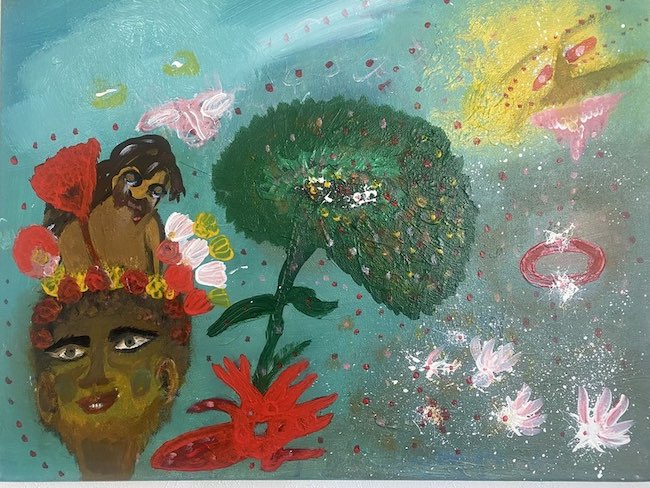Per molti artisti immaginare altri mondi diversi da quello contingente ma al tempo stesso legati a un immaginario comune che li rende possibili, è l’unico modo per riuscire a manifestare un’interiorità che altrimenti si sentirebbe ingabbiata, sia nel caso in cui optassero per uno stile troppo realista, e sia nel caso in cui preferissero un approccio invece completamente indefinito, perché in entrambi gli estremi il loro impulso creativo non si sentirebbe espresso nella sua totalità. Pertanto elevarsi dal quotidiano per tendere verso atmosfere più affini alla loro sensibilità diviene l’unica via per la manifestazione del mondo interiore, quello che riesce a trovare voce solo nell’arte. La protagonista di oggi fa delle sottili visioni una delle sue caratteristiche pittoriche principali.
Nel corso della storia dell’arte, sia quella più lontana che quella più legata alla modernità del Ventesimo secolo, vi fu la tendenza a uscire dalla realtà contingente per entrare in un mondo lontano dall’individuo e fortemente legato, a seconda del periodo storico in cui vissero gli artisti, ai miti, alla religione, alla sfera soprannaturale, alle energie sottili, al mondo dell’inconscio e del sogno e infine a quello dell’immaginazione. Laddove però nei secoli più lontani la scelta dei soggetti mitologici e religiosi era un modo per raccontare visivamente e per istruire la popolazione su concetti che venivano trasmessi solo verbalmente a causa della bassa scolarizzazione, a partire da metà Ottocento i grandi pittori cominciarono a interrogarsi sui misteri che avvolgevano l’essere umano, delle energie invisibili, eppure tangibili, che accompagnavano l’esistenza. Fu proprio in quel periodo che si delinearono le linee guida del Simbolismo che ebbe inOdilon Redon uno dei maggiori rappresentanti; quasi parallelamente sempre in Francia cominciarono a essere gettate le basi di quello che sarebbe diventato uno dei maggiori movimenti di sempre, con modificazioni sulla base del paese di appartenenza degli artisti aderenti, e che prese il nome di Espressionismo. La manifestazione delle sensazioni dell’esecutore dell’opera erano prioritarie su qualsiasi formalismo e su qualsiasi regola accademica, divenendo così la prima vera corrente in cui veniva ufficialmente sancita la rottura con l’arte così come concepita fino a quel momento. Tra il folto gruppo di espressionisti quelli che si distinsero per la loro necessità di fuggire dalla realtà quotidiana europea furono Paul Gauguin il quale viaggiando si innamorò, fino a scegliere di stabilirvisi, della Polinesia a cui dedicò innumerevoli opere attraverso le quali induceva l’osservatore a sognare di quel mondo lontano, per molti solo immaginabile eppure assolutamente possibile, e poi l’irriducibile sognatore Marc Chagall che creava un universo leggero, fatto di emozioni semplici, di immediatezza e di delicatezza con cui suggeriva la necessità di astrarsi dalla contingenza per rendere la vita un viaggio meraviglioso. La medesima tematica, seppure con caratteristiche stilistiche completamente differenti, fu ripresa qualche decennio dopo dal Realismo Magico che sebbene negli anni di esordio mantenesse un forte legame con la realtà contingente arricchita da un senso di mistero e di straniamento dei protagonisti ritratti, nella sua evoluzione tese sempre di più verso l’irrealtà e la creazione di mondi paralleli, improbabili ma possibili, dove la fantasia era capace di disegnare tutto ciò che nella contingenza non esisteva.
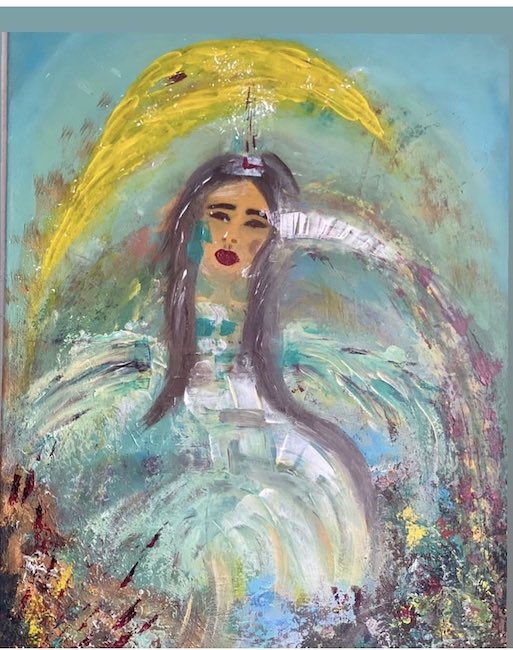
L’artista Natasa Radanovic, di origini montenegrine ma attualmente residente e operante a Malmö in Svezia, ha un approccio completamente affine sia all’Espressionismo sognante di Chagal che alla dimensione dell’evasione di Gauguin aggiungendovi la creazione di universi immaginari riconducibili al Realismo Magico; tuttavia le vibrazioni sottili che avvolgono i suoi dipinti non possono non evocare quel Simbolismo, spogliato però nel suo caso dal mito e dal tratto pittorico realista, che tanto spazio aveva lasciato proprio alla dimensione dell’incomprensibile e dell’inspiegabile decifrabili solo attraverso l’intuizione e non più con la razionalità. Ed è proprio con questo mezzo illogico che è possibile trovare la chiave di lettura delle opere della Radanovic, mettendosi di fronte ai suoi messaggi pittorici con animo aperto e disposto a lasciarsi a trascinare dentro quella magia che è per lei la chiave imprescindibile per liberare la sua delicata interiorità; il tratto espressionista si mescola alla dimensione onirica, irreale, delle ambientazioni narrate che di volta in volta possono raccontare di luoghi incantati in cui l’artista unisce soggetti esistenti seppur inseriti in contesti inusuali, quasi come se nel mondo fatato dell’arte tutto potesse essere plausibile, verosimile proprio perché trasportato in una dimensione a metà tra ciò che è e ciò che potrebbe essere.
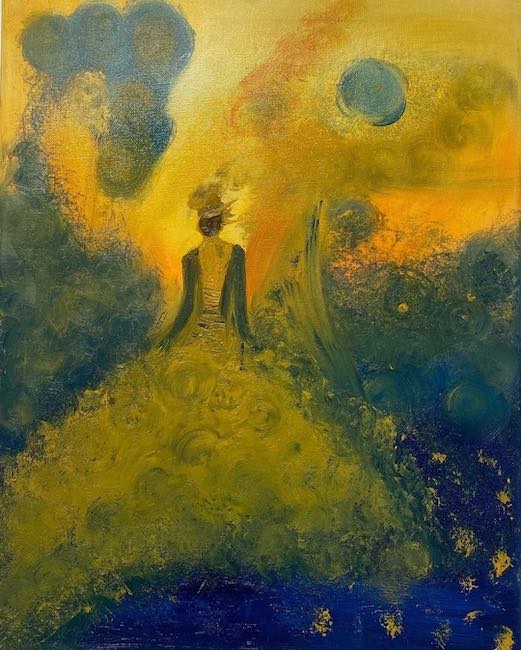
La gamma cromatica si adegua all’emozione che Natasa Radanovic desidera esprimere, senza alcun limite o alcuna linea guida perché ciò che è fondamentale per l’artista è mantenere la propria libertà espressiva che non accetta regole, neanche se imposte da se stessa; essendo di base espressionista non potrebbe mai non rendere i colori stessi protagonisti delle sue tele, perché il gesto pittorico non può prescindere dalle tonalità che diventano esse stesse voci corali dei dipinti i quali non potrebbero sussistere senza l’intensità e le sfumature più o meno delicate, sulla base della narrazione.
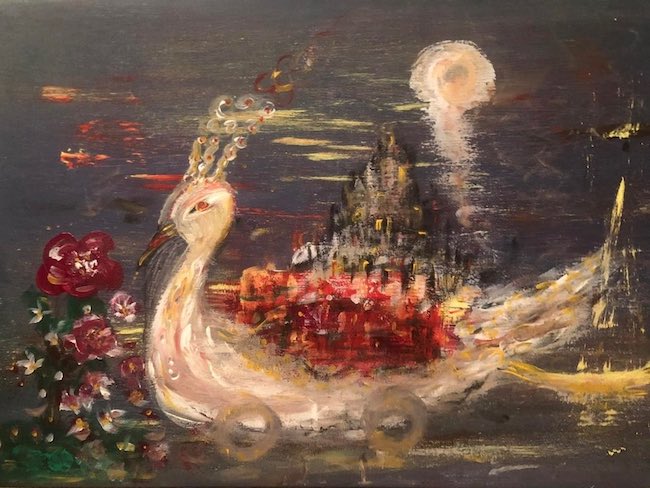
Nell’opera Protector Phoenix infatti l’uccello mitologico in grado di rinascere dalle proprie ceneri sembra voler salvare simbolicamente l’intero mondo costituito da una piccola città che viene trasportata nel suo dorso, come se attraverso la sua magia potesse condurla in un luogo più accogliente di quello cupo e scuro da cui fugge; la luna che si specchia sull’acqua rappresenta la speranza di luce, sempre presente a dispetto delle condizioni a volte avverse, mentre i fiori davanti alla fenice suggeriscono la possibilità di una vita che può sopravvivere e, appunto, rinascere, malgrado tutto.
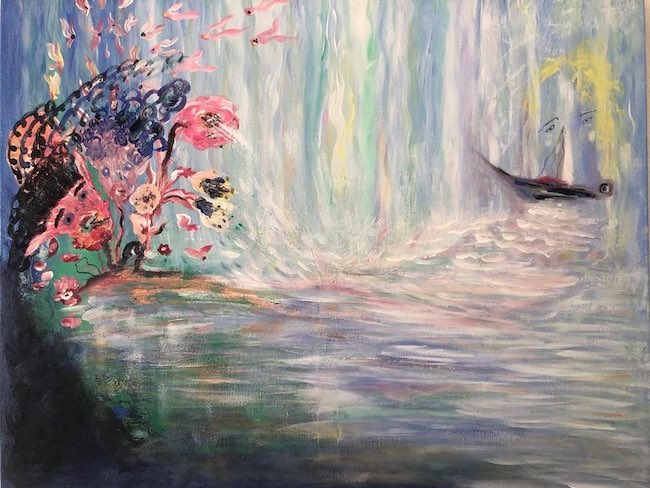
Tanto sono scure le tonalità scelte per l’opera appena descritta, quanto invece sono chiare quelle utilizzate per Secret life dove uno specchio d’acqua tranquillo e calmo accoglie la presenza della vita, non quella dell’essere umano che spesso dimentica di prendersi cura della natura, bensì di quella ai suoi bordi che contempla silenziosa l’acqua, fonte di sussistenza, ma anche il sopraggiungere di un’imbarcazione che potrebbe in qualche modo minare l’equilibrio fino a quel momento mantenuto. La presenza potenzialmente dannosa dell’uomo è introdotta da quello spirito che si intravede nel cielo quasi a voler avvisare la vita intorno allo specchio d’acqua del sopraggiungere di un probabile pericolo. Eppure le tonalità chiare della composizione presuppongono una coesistenza pacifica e nel rispetto dell’habitat naturale, o forse questo è il suggerimento che Natasa Radanovic vorrebbe giungesse come messaggio.
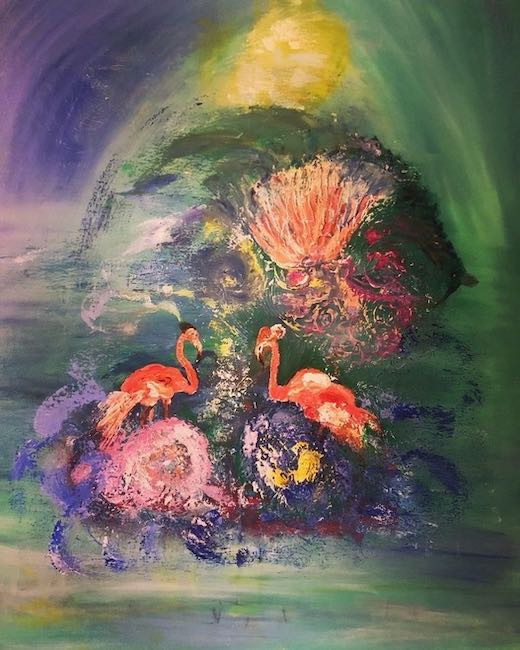
In Flamingo World invece la dimensione è completamente onirica, perché se da un lato i fenicotteri sono animali reali, dall’altro il contesto in cui sono collocati è totalmente destrutturato, non è riconducibile alle calme acque dove di solito stazionano i grandi uccelli bensì appartiene a un luogo non luogo dove il fenicottero è simbolo di delicatezza, di sguardo poetico sul mondo circostante, ma anche di forza nel resistere al peso della vita, alle intemperie che sferzano i mari e le lagune dove vive, tenendosi in equilibrio sulle sue sottilissime zampe. In qualche modo l’opera è una metafora dell’esistenza in cui spesso è necessario mettere in campo tutta la propria resilienza per riuscire a oltrepassare ostacoli e difficoltà che inevitabilmente a periodi alterni sopraggiungono.
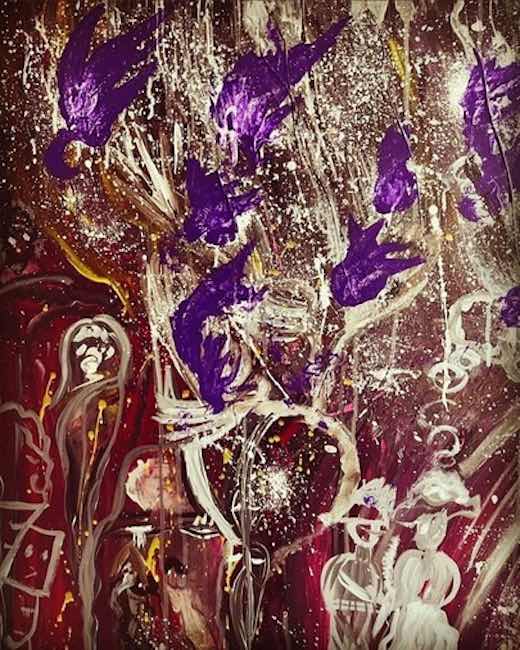
In Falling Angels al contrario, lo sguardo della Radanovic va verso l’inevitabile delusione da parte delle forze celesti nei confronti dei continui e costanti errori commessi dal genere umano che persiste nel combattersi per futili motivi piuttosto che unirsi per cercare armonia ed evoluzione; così gli angeli non possono fare a meno di cadere per cercare di risvegliare gli animi, di prendere per mano qualcuno degli umani e condurlo verso quelle consapevolezze superiori che attraverso i conflitti, le competizioni, l’inseguimento di obiettivi solo materiali, non potranno mai essere raggiunti. Ecco il motivo del rosso di base di questa tela, in qualche modo l’artista sottolinea la realtà terrena, apparentemente senza speranza, contrapposta al colore violetto degli angeli che invece suggerisce l’importanza dell’interiorità, dell’anima, come unico mezzo per salvare l’uomo dalle sue basse pulsioni.
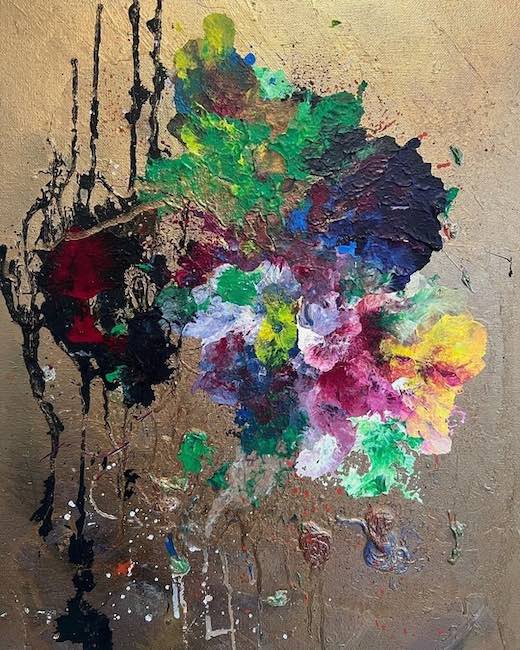
Natasa Radanovic si è formata come autodidatta ma questo non le ha impedito di essere notata fin da subito per la sua espressività, sia nel suo paese di origine, la Bosnia, sia nella nazione dove vive, la Svezia; ha infatti al suo attivo quattro mostre personali e diverse mostre collettive.
NATASA RADANOVIC-CONTATTI
Email: natasaradanovic@msn.com
Facebook: https://www.facebook.com/nradanovic1
Instagram: https://www.instagram.com/art_natasa/
The enchanted visions of Natasa Radanovic’s Expressionism, between fairytale and dream to let emotions flow
For many artists, imagining worlds other than the contingent one, but at the same time linked to a common imagery that makes them possible, is the only way to succeed in manifesting an interiority that would otherwise feel caged in, whether they opt for a style that is too realistic, or whether they prefer a completely undefined approach, because in both extremes their creative impulse would not feel fully expressed. Therefore, elevating themselves from the everyday to tend towards atmospheres more akin to their sensitivity becomes the only way for the manifestation of their inner world, the one that can find a voice only in art. Today’s protagonist makes subtle visions one of her main pictorial characteristics.
Throughout the history of art, both the most distant and the most modern in the 20th century, there has been a tendency to move away from contingent reality and enter a world far removed from the individual and strongly linked, depending on the historical period in which the artists lived, to myths, religion, the supernatural sphere, subtle energies, the world of the unconscious and dreams, and finally to that of the imagination. Whereas in earlier centuries, however, the choice of mythological and religious subjects was a way of visually telling and educating the population about concepts that were only conveyed verbally due to low levels of education, from the mid-19th century onwards the great painters began to question the mysteries that enveloped the human being, the invisible, yet tangible energies that accompanied existence. It was precisely at this time that were outlined the guidelines of Symbolism, which had in Odilon Redon one of its greatest representatives; almost at the same time, also in France, began to be laid the foundations for what was to become one of the greatest movements of all time, with modifications based on the country of origin of the adhering artists, and which took the name of Expressionism.
The manifestation of the feelings of the author of the artwork were prioritised over any formalism and any academic rules, thus becoming the first real current in which the break with art as conceived up to that time was officially sanctioned. Among the large group of Expressionists, those who stood out for their need to escape from everyday European reality were Paul Gauguin, who, while travelling fell in love with Polynesia and chose to settle there, of Polynesia to which he dedicated countless paintings through which he induced the observer to dream of that distant world, for many only imaginable and yet absolutely possible, and then the irreducible dreamer Marc Chagall who created a light universe, made up of simple emotions, immediacy and delicacy with which he suggested the need to abstract oneself from contingency in order to make life a wonderful journey. The same theme, albeit with completely different stylistic characteristics, was taken up again a few decades later by Magic Realism, which although in its early years maintained a strong link with contingent reality enriched by a sense of mystery and estrangement of the protagonists portrayed, in its evolution tended increasingly towards unreality and the creation of parallel worlds, improbable but possible, where the imagination was capable of drawing everything that did not exist in the contingency. The artist Natasa Radanovic, of Montenegrin origin but currently living and working in Malmö, Sweden, has an approach that is completely akin to both Chagal’s dreamy Expressionism and Gauguin‘s dimension of escapism, adding to it the creation of imaginary universes that can be traced back to Magic Realism; however, the subtle vibrations that envelop her paintings cannot fail to evoke that Symbolism, however stripped in her case of the myth and the Realist pictorial trait, which had left so much space precisely to the dimension of the incomprehensible and the inexplicable that can only be deciphered through intuition and no longer through rationality.
And it is precisely through this illogical medium that it is possible to find the key to interpreting Radanovic‘s artworks, confronting her pictorial messages with an open mind and willing to allow oneself to be drawn into that magic that is for her the indispensable key to unlocking her delicate interiority; the expressionist trait is mixed with the dreamlike, unreal dimension of the narrated settings that from time to time can tell of enchanted places in which the artist combines existing subjects even if placed in unusual contexts, almost as if in the fairy-tale world of art everything could be plausible, verisimilar precisely because it is transported to a dimension somewhere between what is and what could be. The chromatic range adapts itself to the emotion that Natasa Radanovic wishes to express, without any limits or guidelines because what is fundamental for the artist is to maintain her own expressive freedom that does not accept rules, not even if imposed by herself; being an expressionist at heart, she could never fail to make the colours themselves the protagonists of her canvases, because the pictorial gesture cannot disregard the tones that themselves become the choral voices of the paintings that could not exist without the intensity and the more or less delicate nuances, on the basis of the narrative. In the canvas Protector Phoenix, the mythological bird capable of rebirth from its own ashes seems to symbolically save the entire world of a small town that is transported on its back, as if through its magic it could lead it to a more welcoming place than the dark and gloomy one from which it flees; the moon reflected in the water represents the hope of light, always present despite the sometimes adverse conditions, while the flowers in front of the phoenix suggest the possibility of a life that can survive and, indeed, be reborn, despite everything. The colours chosen for the artwork just described are as dark as those used for Secret life, where a calm and tranquil stretch of water welcomes the presence of life, not that of the human being who often forgets to take care of nature, but of the life at its edges, silently contemplating the water, a source of subsistence, but also the arrival of a boat that could somehow undermine the balance maintained until then. The potentially harmful presence of man is introduced by that spirit that can be glimpsed in the sky almost as if to warn the life around the stretch of water of the approach of probable danger. Yet the light tones of the composition presuppose peaceful coexistence and respect for the natural habitat, or perhaps this is the suggestion that Natasa Radanovic would like to convey as a message.
In Flamingo World, on the other hand, the dimension is completely dreamlike, because while the flamingos are real animals, the context in which they are placed is totally unstructured, it cannot be traced back to the calm waters where the large birds usually roam, but belongs to a non-place where the flamingo is a symbol of delicacy, of a poetic gaze on the world around, but also of strength in resisting the weight of life, the bad weather that lashes the seas and lagoons where it lives, balancing on its very thin legs. In a way, the work is a metaphor for existence in which it is often necessary to bring all one’s resilience to bear in order to overcome obstacles and difficulties that inevitably arise at alternate times. In Falling Angels, on the other hand, Radanovic‘s gaze goes towards the inevitable disappointment of the celestial forces with the constant and repeted errors committed by the human race, which persists in fighting each other for futile reasons rather than uniting to seek harmony and evolution; thus the angels cannot help but fall to try to awaken souls, to take some of the humans by the hand and lead them towards those higher consciousnesses that through conflict, competition, the pursuit of merely material goals, can never be achieved. This is the reason for the basic red colour of this canvas, somehow the artist emphasises the earthly, apparently hopeless reality, contrasting it with the violet colour of the angels, which instead suggests the importance of interiority, of the soul, as the only means to save man from his baser drives. Natasa Radanovic trained as a self-taught artist, but this did not prevent her from being noticed right from the start for her expressiveness, both in her country of birth, Bosnia, and in the country where she lives, Sweden. In fact, she has four solo exhibitions to her credit and several group exhibitions.


